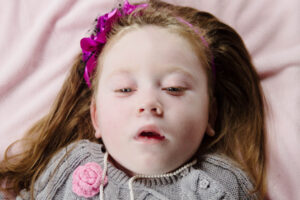Prader-Willi syndrome
Humans have 23 pairs of chromosomes that encode all genetic materials. In trisomy 15 there is an extra chromosome in the 15th pair. This extra chromosome causes a multitude of birth defects. For live births, trisomy 15 causes one of the following two syndromes:
- Prader-Willi syndrome
- Angelman syndrome
It is associated with the absence of the active Prader-Willi gene on the long arm of chromosome 15.
- Microdeletion of paternal 15q11-13 (70% of cases). This is the most common cause.
- Maternal uniparental disomy of chromosome 15.
Features
It affects 1 in ten thousand live births. People with Prader-Willi syndrome want to eat constantly because they never feel full (hyperphagia), and they usually have trouble controlling their weight. Many complications of Prader-Willi syndrome are due to obesity.
- Decreased muscle tone during infancy
- Dysmorphic features
- Short stature
- Hypogonadism and infertility (gonadotrophin hormone insufficiency)
- Learning difficulties (mild to moderate intellectual impairment).
- Childhood obesity
- Poor sucking reflex
- Behavioral problems in adolescence (stubborn, angry, controlling, and manipulative behavior).
- Small hands and feet

Angelman syndrome
Angelman syndrome is a genetic disorder that primarily affects the nervous system. Characteristic features of this condition include developmental delay, intellectual disability, severe speech impairment, problems with movement and balance (ataxia), epilepsy, and small head size. Individuals with Angelman syndrome typically have a happy, excitable demeanor with frequent smiling, laughter, and hand-flapping movements.
Many of the characteristic features of Angelman syndrome result from the loss of function of a gene called UBE3A. Most cases of Angelman syndrome are not inherited, although in rare cases a genetic change responsible for Angelman syndrome can be inherited from a parent. Treatment is aimed at addressing each individual’s symptoms and may include antiepileptics for seizures; physical, occupational, and speech therapy; and special education services.
Inheritance
Most cases of Angelman syndrome are not inherited, particularly those caused by a deletion in the maternal chromosome 15 or by paternal uniparental disomy. These genetic changes occur as random events during the formation of reproductive cells (eggs and sperm) or in early embryonic development. In these instances, people typically have no history of the disorder in their family.
Diagnosis
Angelman syndrome may be suspected if a child’s development is delayed and they have the syndrome’s distinctive characteristics.
A blood test is used to confirm the diagnosis. Several genetic tests will be done on the blood sample. These tests look for:
- any chromosomes or pieces of chromosomes that are missing
- changes in the mother’s or father’s UBE3A gene that they may have passed on
- changes in the child’s UBE3A gene that would stop it from working
For each child with Angelman syndrome, it’s important to know the genetic change that caused the condition. This helps to determine whether there’s a chance you might have another child with Angelman syndrome.
Most children with Angelman syndrome are diagnosed between the ages of 9 months to 6 years, when physical and behavioural symptoms become apparent.
If your child is diagnosed with Angelman syndrome, you will be able to talk to a genetic doctor about what support they might need.
Management
- Anti-epileptic medicine to control seizures
- Physiotherapy may improve posture, balance, and walking ability; it’s also important to prevent permanent stiffening of the joints as people with Angelman syndrome get older
- Communication therapy may help them develop non-verbal language skills, such as sign language and using visual aids; using iPad applications and similar tablet devices may also help
- Behavioral therapy may be recommended to help overcome behaviors you find hard to manage, such as hyperactivity and a short attention span



